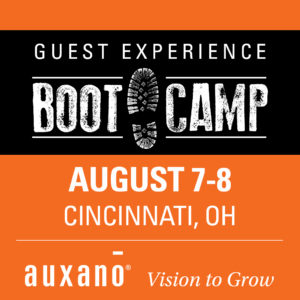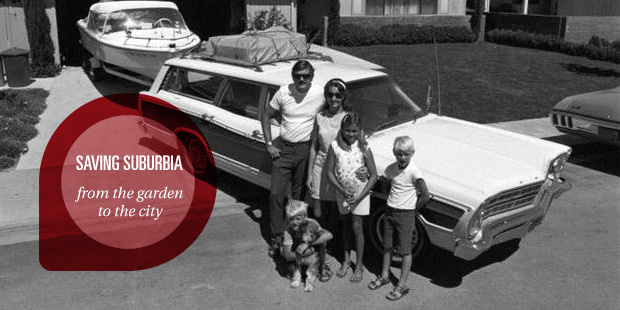
The Exceptional Guest Experience, Part 1: PLACE
At Auxano, we’ve walked with more than 500 churches through a process called the Guest Perspective Evaluation. And when they’re done, they all ask, “What’s next?”
Amazingly, most church leaders don’t actually have a plan they can use to improve their Guest Experience!
Ask them about their strategy and you’ll discover it boils down to this:
We’ll be friendlier.
It’s understandable. Church leaders are too busy on the weekend to actually understand what Guests see – and experience – to really know how to make things better. After all, your church is “friendly,” right? And that is all you need to have a good Guest Experience.
But why settle for good?
An exceptional Guest Experience ministry doesn’t have to be complicated. We recommend you execute on just three things:
- Place
- Process
- People
Focusing on these three things will allow you to welcome first time Guests, welcome back returning Guests, and create a culture of hospitality within your church that extends your ministry beyond your walls.
The catch?
Each of these three elements shares one requirement: paying attention to details.
It’s impossible to have an exceptional Guest Experience unless you pay attention to details.
This is such an important principle that we are devoting two issues of SUMS Remix to this concept. What is SUMS Remix? It’s one of the other great parts of my job: a “book summary” published every two weeks, with each issue listing excerpts from three books addressing a challenging problem leaders face.
For the first issue, we will look at the three components of an EXCEPTIONAL Guest Experience, with lessons from the world leader in Guest Experience – the Disney organization. The second issue will highlight lessons from another area of hospitality – the pro chef’s kitchen – on how churches can provide an EXCEPTIONAL Guest Experience.
Want to learn how to create an EXCEPTIONAL Guest Experience at your church? Check out Auxano’s Guest Experience Boot Camp, coming to Cincinnati, OH August 7-8.
The PLACE where you welcome Guests
THE QUICK SUMMARY – One Little Spark, by Marty Sklar
We’ve all read about the experts: the artists, the scientists, the engineers-that special group of people known as Imagineers for The Walt Disney Company. But who are they? How did they join the team? What is it like to spend a day in their shoes?
Disney Legend Marty Sklar wants to give back to fans and answer these burning questions. When Marty was president of Walt Disney Imagineering, he created a list of principles and ideals for the team, aptly named Mickey’s Ten Commandments. Using this code of standards as his organizational flow, Marty provides readers with insights and advice from himself and dozens of hands-on Imagineers from around the globe. It’s a true insider’s look like no other!
Note: This issue of SUMS Remix was already in production when I learned of the passing of Marty Sklar on Thursday, 7/27/17. Read more about Marty here.
A SIMPLE SOLUTION
Walt Disney had long dreamed of a place where people could be immersed in the stories and films his studio was producing. He began planning that place – which would become known as Disneyland – in the 1940s.
Even a genius like Walt Disney knew he could not create such a place by himself. In 1952, he began to assemble a team to help realize his dream. Beginning with some of his most trusted animators and art directors, they approached the creation of Disneyland in the same way as they would in an art project.
Since the people who designed and built Disneyland came from the animation side of the business, they treated its settings as integral and important parts of the park from the very first. Disneyland was going to be a living movie that its guests would experience by moving through it. And, as in animated films, to make that vision come to life, the audience had to have the opportunity to become totally immersed in the experience.
How does “Place” deliver an exceptional experience? The better question is, how does it not?
Walt Disney realized that a visit to an amusement park could be like a theatrical experience – in a word, a show. Walt saw that the Guests’ sense of progressing through a narrative, of living out a story told visually, could link together the great variety of attractions he envisioned for his new kind of park. While traveling through their stories, Guests would encounter, and even interact with, their favorite Disney characters, and who would be transformed, as if by magic, from their two-dimensional film existence into this special three-dimensional story world.
Marty Sklar, who retired from the Disney organization in 2009, led the planning and creative development of nine Disney parks around the world. Part of the Disney team since 1955, Sklar has a unique perspective on the ideation and creation of the magic of place, and the importance of attention to details all along the journey.
For me, these principles have formed the standard the Imagineers have used to create the Disney park experiences around the world. When we followed them closely, we created magic.
Know your audience – Identify the prime audience for your attraction or show before you begin design
Wear your Guests’ shoes – Insist that your team members experience your creation just the way Guests do
Organize the flow of people and ideas – Make sure there is a logic and sequence in our stories and the way Guests experience them
Create a wienie (visual magnet) – Create visual “targets” that will lead Guests clearly and logically through your facility
Communicate with visual literacy – Make good use of color, shape form, texture – all the nonverbal ways of communication
Avoid overload – create turn-ons – Resist the temptation to overload your audience with too much information and too many objects
Tell one story at a time – Stick to the story line; good stories are clear, logical, and consistent
Avoid contradictions – maintain identity – Details in design or content that contradict one another confuse an audience about your story or the time period it takes place in
For every once of treatment, provide a ton of treat – Walt Disney said you can educate people, but don’t tell them you’re doing it. Make it fun!
Keep it up! (Maintain it) – In a Disney park or resort, everything must work. Poor maintenance is poor show!
Marty Sklar, One Little Spark
A NEXT STEP
As designers, the Imagineers create spaces – guided experiences that take place in carefully structured environments, allowing the Guests to see, hear, smell, touch, and taste in new ways. In effect, Imagineers transform a space into a story place.
Ultimately, the Imagineers gave Guests a place to play, something Walt believed that adults needed as much as children. The design of the Imagineers gives power to the Guests’ imagination, to transcend their everyday routine. Walt Disney insisted that Guests should “feel better because of” their experiences in Disney theme parks, thus establishing the art of the show.
For the Imagineers, that meant considering everything within and relating to the parks as design elements. To build effective story environments and assure Guest comfort, the designers realized that they always had to assume the Guests’ position and point of view, and just as Walt did, to take the Guests’ interests to heart and defend them when others didn’t think it mattered.
It is up to the designers to provide Guests with the appropriate sensory information that makes each story environment convincing. This means that design considerations go beyond the attractions themselves to the service and operations staff, transportation, restaurants, shops, rest rooms – even the trash cans.
Initially, the Imagineers used the knowledge gained from their experience in films, but they soon found that their Guests themselves would teach them what they most needed to know about theme park design and operation.
When designers see Guests in their natural states of behavior, they gain a better understanding of the space and time Guests need in a story environment.
Using “Mickey’s Ten Commandments” list above as a guide, work with your team to evaluate your current “Place.”
Write the Ten Commandments phrases down the left side of a chart tablet. Next, draw two columns on the remaining space. Label the first column with a “+” and the second column with a “-“.
Using each of the Ten Commandment phrases, walk through your current environments, listing the ones that are working in the “+” column and the ones that are not working in the “-“ column.
After finishing your work, create an action plan to improve the environments in the “-“ column. Be sure to include a timeline and leader responsible for the work.
Are you expecting Guests this weekend? Beyond a simple “yes” or “no,” the extent to which you answer this question will go a long way in determining if your first-time Guests become second-time guests.
It’s all in the details.
Excerpt taken from SUMS Remix 72-1, issued August 2017.
This is part of a weekly series posting excerpts from one of the most innovative content sources in the church world: SUMS Remix Book Summaries for church leaders.
SUMS Remix takes a practical problem in the church and looks at it with three solutions; each solution is taken from a different book. Additionally, a practical action step is included with each solution.
As a church leader you get to scan relevant books based on practical tools and solutions to real ministry problems, not just by the cover of the book. Each post will have the edition number which shows the year and what number it is in the overall sequence. (SUMS Remix provides 26 issues per year, delivered every other week to your inbox).
>> Subscribe to SUMS Remix <<


Tags: Guest Experience Boot Camp, Guest Experiences, Marty Sklar, One Little Spark, Place, SUMS Remix





















